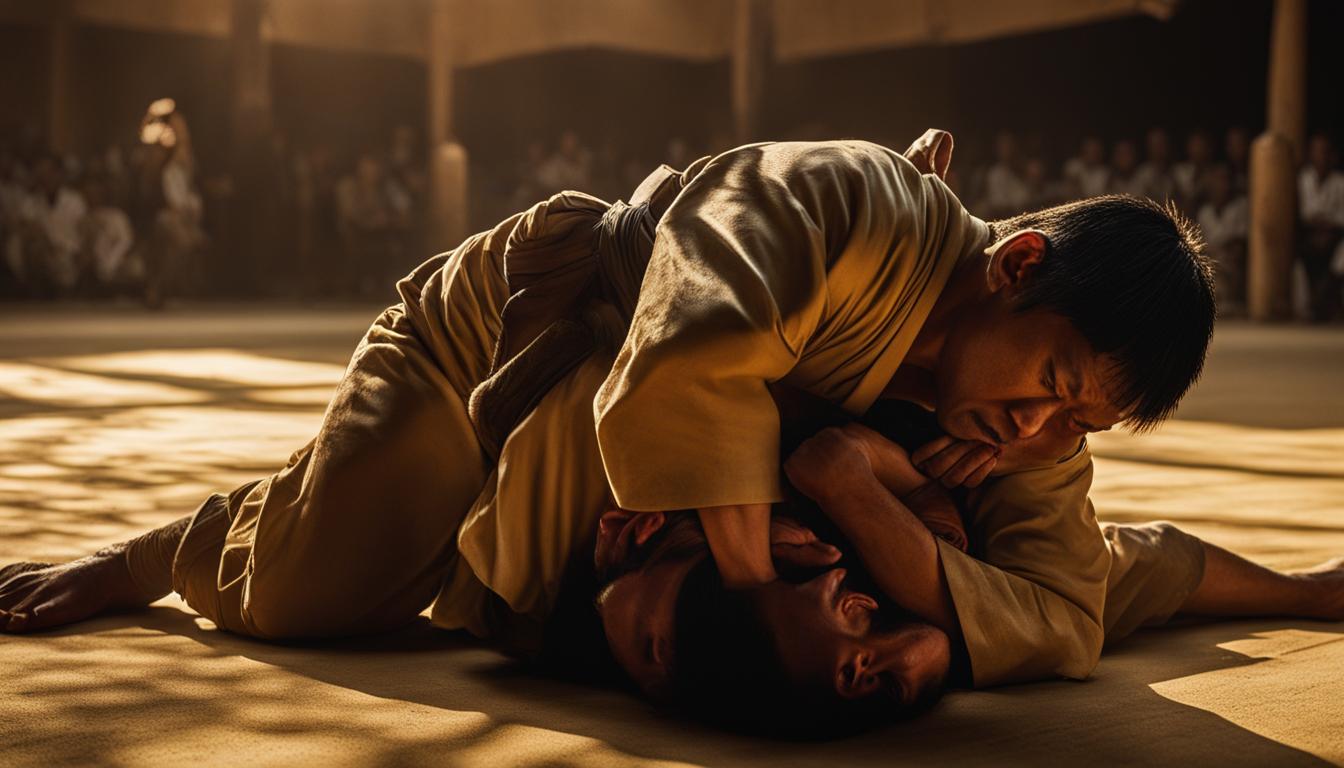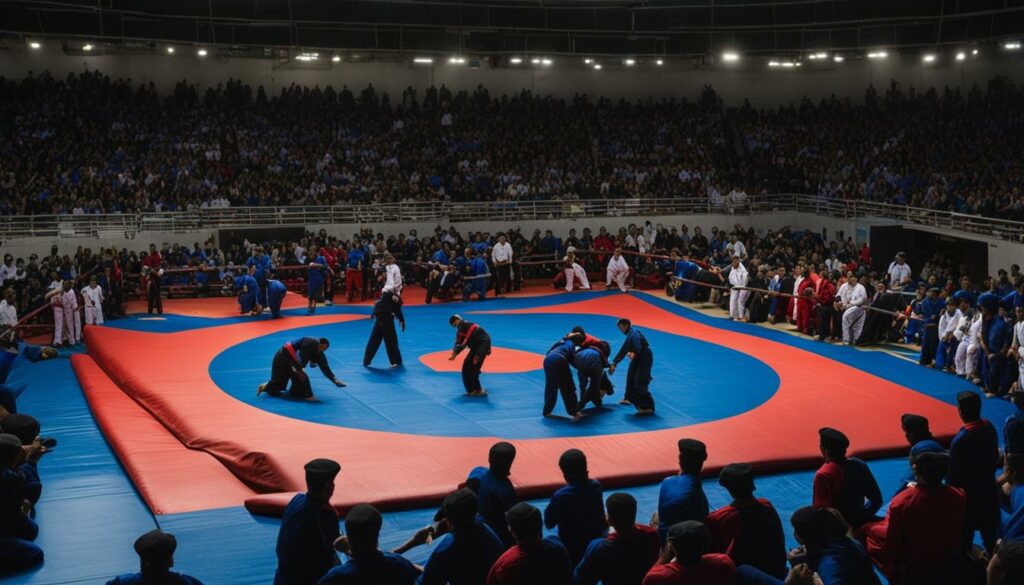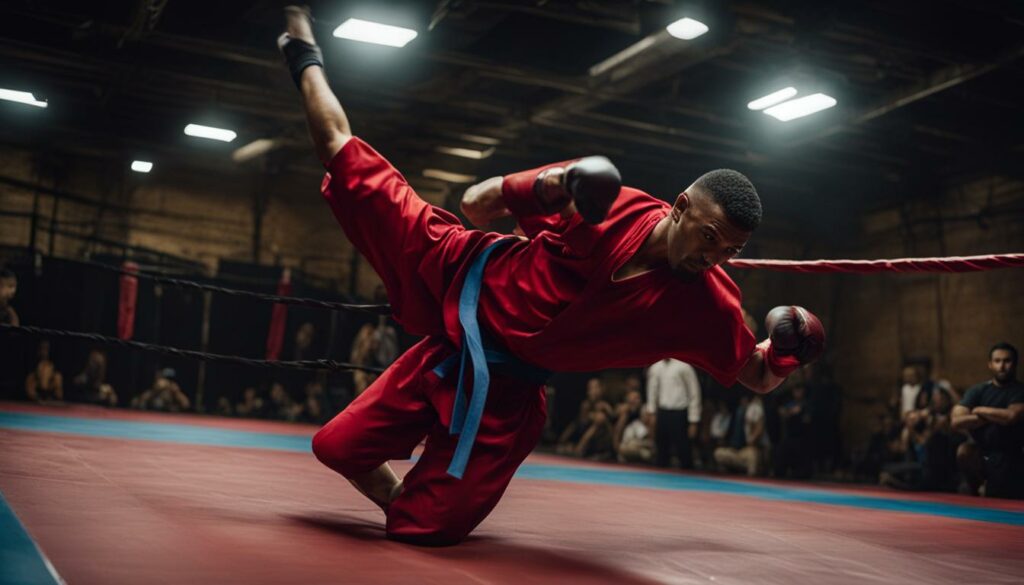Sambo, the dynamic Russian martial art, has taken me on a thrilling journey of self-discovery and mastery. As a passionate sambo fighter, I have delved into the captivating blend of ancient combat techniques and modern adaptations that make up this unique fighting style.
Combining elements of Judo, Jiu-Jitsu, and various types of wrestling, Sambo showcases a diverse range of techniques that are both powerful and effective. From throws and locks to ground control maneuvers, the art of Sambo is a force to be reckoned with.
Key Takeaways:
- Sambo is a dynamic Russian martial art that blends ancient combat techniques with modern adaptations.
- It incorporates elements of Judo, Jiu-Jitsu, and wrestling, making it a unique and powerful fighting style.
- Sambo techniques include throws, locks, and ground control maneuvers, emphasizing both standing and ground fighting.
- Training in Sambo offers numerous benefits for physical and mental well-being, including strength, agility, and self-defense skills.
- Sambo has gained recognition in mixed martial arts (MMA) and continues to grow in popularity worldwide.
The History of Sambo: From Military Training to Worldwide Practice
Sambo, a martial art originating from the former Soviet Union, has a rich history that traces back to its development as part of military training. Created by Vasili Oshchepov and Viktor Spiridonov, Sambo emerged from the fusion of various martial arts techniques, resulting in a unique and effective combat system.
In 1938, Sambo gained official recognition and quickly spread beyond military circles, becoming widely practiced by public servants and citizens. Its practicality and versatility made it popular among individuals seeking to enhance their self-defense skills. With time, Sambo began to gain international attention and found its way to the United States and Europe.
Today, Sambo is practiced worldwide and revered for its effective techniques, particularly in takedowns, ground control, and leg locks. Its evolution from military training to a global martial art exemplifies its adaptability and enduring appeal.
Notable Milestones in the History of Sambo:
- Development by Vasili Oshchepov and Viktor Spiridonov
- Official recognition in 1938
- Expansion beyond military circles
- International spread to the United States and Europe
- Worldwide practice and popularity
| Year | Milestone |
|---|---|
| 1938 | Official recognition of Sambo as a sport |
| 1957 | First International Sambo Tournament |
| 1991 | Sambo included in the World Combat Games |
| 2018 | Inclusion of Sambo in the Youth Olympics |
The Unique Fighting Techniques of Sambo
Sambo is renowned for its diverse and unique fighting techniques that encompass a wide range of throws, locks, and ground control maneuvers. This martial art emphasizes both standing and ground fighting, making it a highly versatile combat style suitable for various situations.
In Sambo wrestling, competitors aim to take down their opponents and score points through powerful throws and well-executed holds. These techniques require a combination of strength, agility, and precise timing to achieve success in the sport.
One of the distinguishing features of Sambo is its adherence to specific rules and regulations that ensure fair and safe competition. The rules dictate the permissible techniques, prohibited moves, and guidelines for sportsmanship, creating an environment conducive to healthy competition.
The Key Elements of Sambo Techniques:
- Throws: Sambo practitioners utilize a wide array of throws to destabilize their opponents and gain the upper hand in a match.
- Locks: Various joint locks, such as arm bars and leg locks, are employed to immobilize opponents and force them into submission.
- Ground Control: The art of maintaining control over an adversary on the ground is crucial in Sambo. Practitioners develop comprehensive skills in pinning, escaping holds, and transitioning between different positions.
These techniques, when executed proficiently, make Sambo highly effective for both self-defense and competitive fighting. The emphasis on practicality ensures that practitioners can defend themselves efficiently in real-life situations, while the competitive aspect hones their skills, strategy, and mindset under pressure.
“Sambo techniques require a combination of athleticism, technical proficiency, and mental agility. It is a true test of skill and adaptability in combat.”
Whether standing or on the ground, the continuous development of skills in throws, locks, and ground control techniques shapes Sambo practitioners into formidable opponents in any fighting scenario.
The Sambo Techniques in Action:
To better understand the effectiveness of Sambo techniques, let’s explore a common scenario in a Sambo wrestling match. Consider the following situation:
Competitor A manages to throw Competitor B to the ground, scoring points in the process. Competitor A then takes advantage of the opportunity to pin Competitor B using a combination of ground control techniques and applying pressure on strategic joints. This immobilizes Competitor B and forces them to concede victory to Competitor A.
Through this example, it becomes evident that Sambo techniques are not only effective in achieving scoring opportunities but also in gaining dominant positions and forcing opponents into submission or forfeiture.
The visual representation below showcases some of the key techniques utilized in Sambo:
| Technique | Description |
|---|---|
| Throws | A variety of throws are employed, including hip throws, shoulder throws, and leg trips. These techniques capitalize on an opponent’s balance and momentum to forcefully bring them to the ground. |
| Locks | Joint locks, such as arm bars and leg locks, are used to incapacitate opponents by hyperextending or immobilizing their limbs. These techniques exploit vulnerable joints and ligaments to gain control over the adversary. |
| Ground Control | Sambo practitioners employ various techniques to secure advantageous positions on the ground, such as mounts, side control, and back control. This allows them to control an opponent’s movement, limit their escapes, and execute effective strikes or submissions. |
The Sambo Federation and Tournaments
The Sambo Federation plays a crucial role in the development and promotion of Sambo worldwide. As the governing body for the sport, it is responsible for organizing tournaments and ensuring that competitions adhere to standardized rules and regulations.
Sambo tournaments are held at various levels, providing opportunities for athletes to showcase their skills and compete against top-level opponents. From local competitions to international championships, these tournaments attract participants from different countries, creating a vibrant and diverse community of Sambo practitioners.
Through these tournaments, both aspiring and seasoned athletes can test their abilities and challenge themselves in a competitive environment. The camaraderie fostered among participants further contributes to the growth and popularity of Sambo as a dynamic martial art.
The Benefits of Training in Sambo
Training in Sambo offers numerous benefits for both physical and mental well-being.
One of the key advantages of Sambo training is its ability to improve strength, agility, and flexibility. The dynamic and diverse techniques used in Sambo help to develop and tone muscles, resulting in increased overall strength. The emphasis on movement and quick reactions also enhances agility, allowing practitioners to move swiftly and effectively.
Another significant benefit of Sambo training is its focus on practical and effective self-defense techniques. Unlike other martial arts that may require years of training before being applicable in real-life situations, Sambo techniques can be applied immediately. These techniques include throws, holds, and strikes designed to subdue opponents efficiently and effectively.
Additionally, practicing Sambo promotes discipline, self-confidence, and mental resilience. The training requires dedication, perseverance, and adherence to strict rules and techniques. As a result, practitioners develop discipline and mental strength, which carries over into other aspects of life. The self-confidence gained from mastering Sambo techniques further boosts one’s overall well-being and sense of personal achievement. Moreover, the mental resilience acquired through rigorous training enables practitioners to face challenges with composure and determination.
Overall, Sambo training is a holistic martial art that nurtures not only the body but also the mind and spirit. It provides practitioners with physical fitness, self-defense skills, and mental fortitude, making it a well-rounded practice for anyone seeking personal growth and empowerment.
Sambo in Mixed Martial Arts
Sambo, a dynamic Russian martial art, has made a significant impact in the world of mixed martial arts (MMA). Renowned fighters like Fedor Emelianenko and Khabib Nurmagomedov have showcased the exceptional skills and techniques that Sambo offers.
The combination of leg locks, throws, and ground control techniques in Sambo brings a unique flavor to MMA. These techniques have not only influenced other martial arts but have also contributed to the evolution of the sport.
Sambo’s effectiveness in real-life combat situations has made it a sought-after discipline among MMA fighters. Its versatility and practicality make it a valuable addition to their fighting repertoire.
As Sambo continues to gain recognition in the MMA world, it solidifies its position as a powerful and respected martial art. The impact it has made and its ongoing influence validate the significance of Russian martial arts on a global stage.
Quotes:
“Sambo’s techniques have allowed me to excel in MMA. The diverse skill set and emphasis on ground control have given me an edge over my opponents.” – Fedor Emelianenko
“Training in Sambo has been instrumental in my success as an MMA fighter. The discipline and techniques I’ve learned have shaped me into the fighter I am today.” – Khabib Nurmagomedov
The Growing Popularity of Sambo
While Sambo may not be as globally popular as Brazilian Jiu-Jitsu, it has seen a steady increase in popularity in recent years. More people in the USA and Europe are taking up Sambo, appreciating its versatile techniques and effectiveness in self-defense.
The sport’s growing popularity can also be attributed to the success of Sambo practitioners in various combat sports, as well as the influence of social media and the internet in spreading awareness about the art.
Sambo’s future looks bright, with more enthusiasts discovering its benefits and embracing its training.
With its unique blend of Judo, Jiu-Jitsu, and wrestling techniques, Sambo offers a dynamic and effective approach to martial arts training. As more practitioners showcase their skills and achievements, the global recognition of Sambo continues to grow.
Sambo Success in Combat Sports
Sambo fighters have achieved remarkable success in various combat sports, further fueling the interest in this Russian martial art. Athletes like Fedor Emelianenko and Khabib Nurmagomedov have made a name for themselves with their dominant performances in mixed martial arts (MMA), displaying the effectiveness of Sambo techniques on the global stage.
This success has sparked the curiosity and enthusiasm of martial arts enthusiasts, motivating them to explore the world of Sambo and experience its unique training methods firsthand.
Social Media and Internet Impact
The advent of social media and the internet has played a significant role in popularizing Sambo. With the click of a button, individuals can access videos, tutorials, and articles that showcase the power and versatility of this Russian martial art.
These digital platforms have created a worldwide community of Sambo practitioners and enthusiasts, allowing them to connect, exchange knowledge, and share their passion for the sport.
A Bright Future for Sambo
As more people discover the benefits of training in Sambo, its popularity continues to grow. From recreational practitioners to competitive athletes, the appeal of this Russian martial art spans across different skill levels and age groups.
With its rich history, practical techniques, and proven effectiveness, Sambo is poised to make an even greater impact in the world of martial arts. Whether for self-defense, physical fitness, or personal growth, the allure of Sambo’s unique training experience will continue to attract new enthusiasts and ensure its enduring appeal for years to come.
Conclusion
As I reflect on my journey in Sambo, I am in awe of the power and uniqueness of this Russian martial art. From its humble beginnings as a military combat sport, Sambo has evolved into a worldwide practice that continues to captivate martial arts enthusiasts like myself. The combination of takedowns, ground control skills, and leg locks in Sambo make it a formidable discipline for both self-defense and competitive fighting.
With its growing popularity and influence in MMA, Sambo is solidifying its position as a force to be reckoned with in the martial arts world. The techniques learned in Sambo training empower fighters to adapt to various combat situations, honing their tactical skills and resilience. Whether you are just beginning your journey in martial arts or seeking to expand your training repertoire, Sambo offers an exhilarating path of self-discovery and mastery.
Sambo is not just a martial art; it is a way of life that promotes discipline, self-confidence, and mental strength. Through its dynamic and diverse techniques, Sambo enhances physical attributes such as strength, agility, and flexibility. Its practical and effective moves make it a valuable tool for personal protection. As Sambo gains recognition, more individuals are embracing its training, appreciating its versatile techniques, and experiencing the numerous physical and mental benefits it offers.
Source Links
- https://marylandsystema.com/
- https://www.amazon.com/kindle-dbs/search?offset=1140&rootId=17742222011&rootName=Kindle Books for Others&categoryView=child-category-view&sort=RELEVANCE&qid=1581941421&bbn=156481011&node=159860011&view=LIST&_encoding=UTF8&feature_nineteen_browse-bin=9045887011&page=1&didRefine=1
- https://evolve-mma.com/blog/the-history-and-origins-of-sambo/



